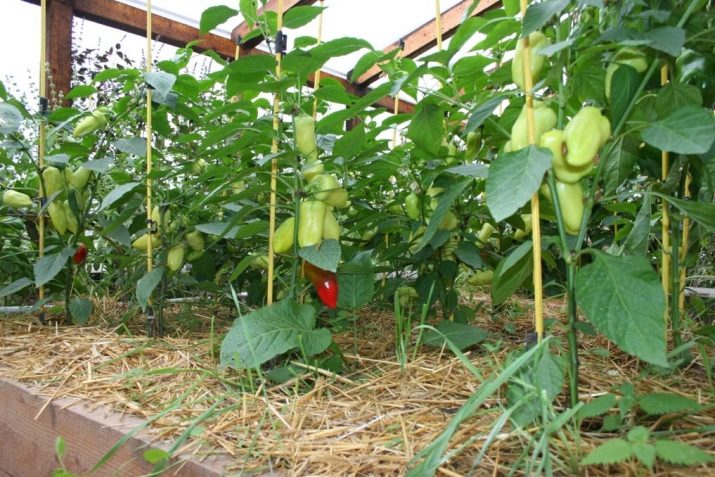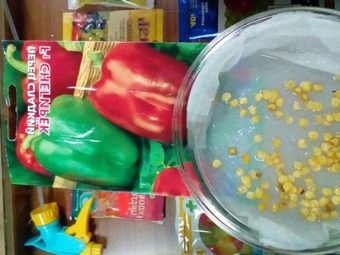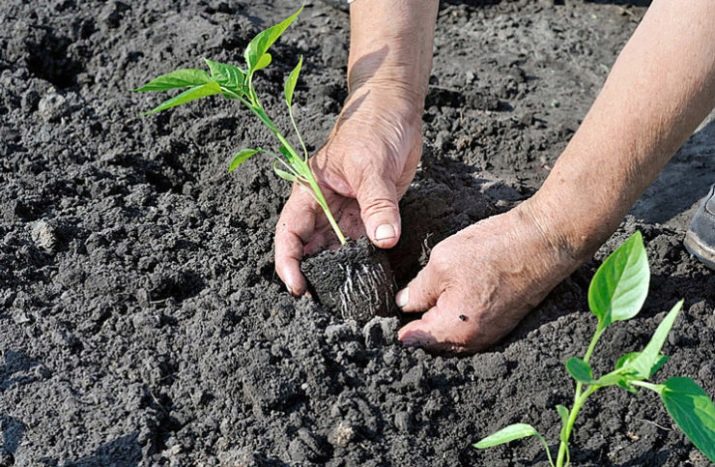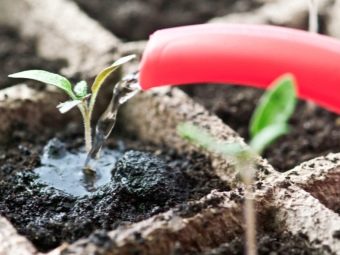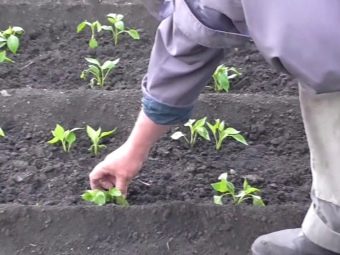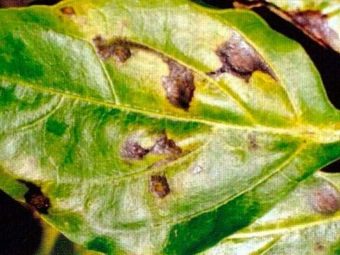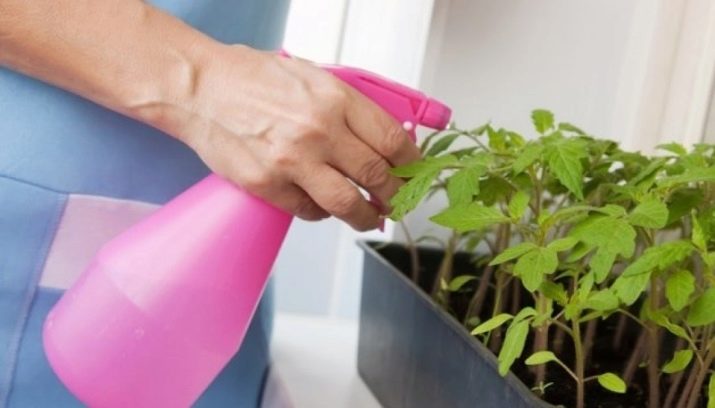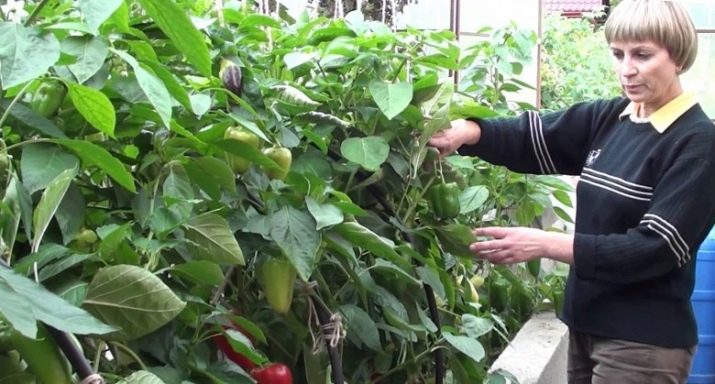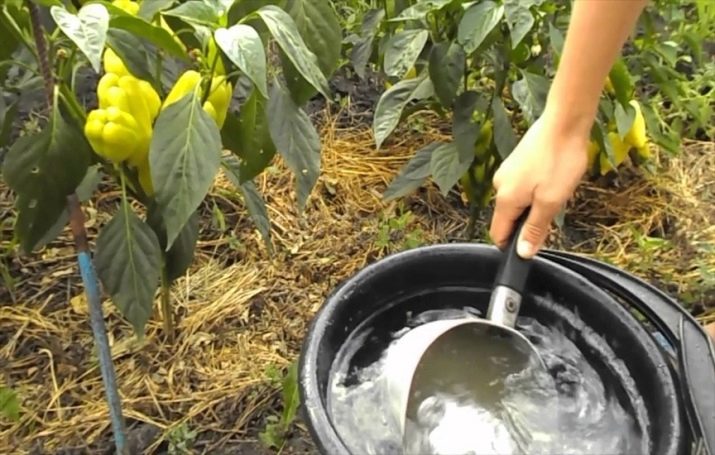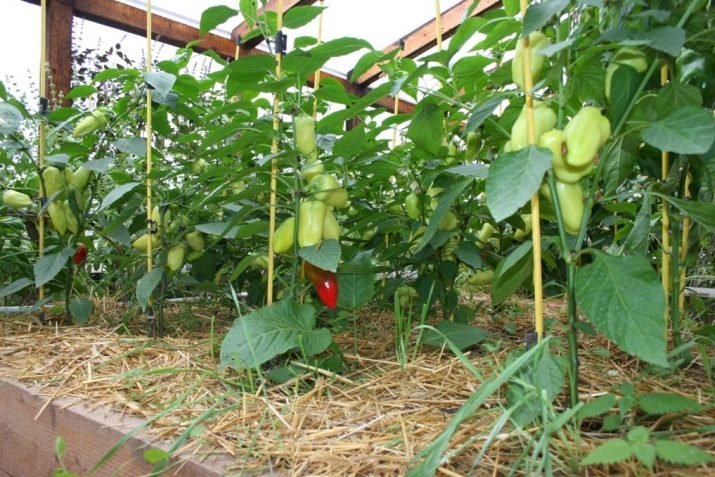Growing peppers: seed preparation, planting and care

Pepper is considered the most popular crop in the world, therefore many gardeners prefer to cultivate it. Vegetable can be grown both in greenhouses and in open soil. To get a high and stable crop, this plant needs proper care and conditions for growth.
Preparatory work
Before you start growing peppers, a number of preparatory activities must be carried out on the beds. First of all, you should determine the place of sowing and control the soil. If the earth is crumbly and loose, then it is suitable for comfortable growth of culture. In addition, it is also important to carry out the following work:
- Thoroughly clean the plot, where you plan to plant vegetables, from debris and grass. The soil must be further loosened and looted. In the case when the cottage is located on sour soils and loams, manure will have to be added to the ground, since the root system will not have enough oxygen and nutrient moisture.
- Make a marking beds. To do this, given the varietal characteristics, measure the distance between the beds.
- Containers from which seedlings will be planted should be watered well overnight. So the shoots will be easier to remove from the containers without damaging the rhizomes.
- It is recommended to put a garden mixture consisting of organic fertilizers, sawdust and ash into each hole for additional plant nutrition. In this case, the manure is best used in autumn, as a fresh plant can burn. Some gardeners also prefer to make ammonium nitrate at the root of the seedlings. She, in addition to nutritional properties, will be able to protect the culture from such a pest as a bear.
If the gardener does not have the opportunity to install a greenhouse on the site and pre-grow seedlings in it, then the sowing of seeds must be carried out immediately on open soil. Prior to this, vegetable seeds undergo preplant treatment - they are soaked in warm water and kept for 5 hours, after full swelling, the seeds are placed on a wet cloth for several days and left in a dark place with a temperature of +20 degrees.
The sowing material prepared in this way will provide instant seedlings the very next day after sowing, if constant mulching is carried out on the beds.
How to plant?
When planting pepper seedlings in the open field, it is important to consider that good predecessors for it are carrots, pumpkin, zucchini, onions, celery and cabbage, bad ones are tomatoes, potatoes and eggplant. It is advisable to start planting from mid-June using a 40 × 40 cm scheme. For seedlings in a greenhouse with a covering material, transplantation is recommended in early April. Peppers should be placed in the pits at the same depth at which they grew in planting containers, taking care not to damage or expose the roots.
Pepper likes warm earth, so if you want to get a good harvest, the soil should be heated.
To ensure good watering and ventilation of the plant, it is necessary to increase the height of the beds to 25-55 cm. Since this culture is characterized by high pollinating, the distance between different varieties of vegetables should be maximized. Especially it concerns bitter pepper - it is necessary to separate sweet from it by high plantings from sunflower, a tomato or corn.
As practice shows, the culture of seedlings develops much faster than sown from seeds into open soil. The ripening time of the latter is slowed down and fruiting is significantly reduced, therefore, in order to properly grow peppers, planting in greenhouses is used.
Ready seedlings are planted in open ground, observing the following rules:
- All earthworks is best to start in the evening, when there is no sun. If the transplant is performed in the heat, then the seedlings will be much more difficult to recover and settle down. Ideally, when the landing will coincide with the period of rain, then the earth is wet and the seedlings will tolerate the adaptation painlessly.In that case, if it is grown on its own, before planting it, you need to take out the plants to fresh air, so that they are accustomed to the environmental temperature regime.
- Before the pepper is removed from the pots, it should be poured abundantly. Bushes need to get carefully, trying not to damage the soil in which they grew. This will help them to endure "stress." It is advisable to keep purchased material rolled up in a damp cloth in a cool place. Optionally, the roots of pepper can be further processed with special growth promoters. They will help to quickly take root and properly form seedlings.
- Between the beds it is recommended to leave a distance of 50-60 cm for undersized bushes and 70 cm for large tall ones. At the same time, it is desirable to plant the seedlings from each other in increments of 25-30 cm. With dense planting, the culture will not be able to receive the required amount of light and care for it will become difficult, since access to fertilizer and soil loosening will be limited.
Despite the fact that the agricultural peppers are not easy and the plant is demanding to care, if you follow all the above rules, every gardener can get a wonderful harvest.
Disease protection
Pepper, like most other crops, is prone to viral, bacterial and fungal diseases. Such problems mainly arise due to non-compliance by the gardener with optimal growing conditions, as well as inconsistent weather. In order to prevent diseases of the pepper, the seedlings must be timely fed and a number of preventive measures are taken. The most common types of plant diseases are:
- Blackleg. It is a dangerous defeat that can actively spread throughout all areas of young shoots. This is a fungal disease that manifests itself in the spring regardless of whether the plant is in greenhouses or on open soil. If darkening and constriction of the root neck with a characteristic gray bloom is noticed, then urgent measures should be taken, otherwise the fungus will completely cover the root system and the seedlings will begin to wither and die. This situation can be remedied by reducing the humidity and regularly breaking through crops, avoiding their density. It is desirable to water the beds with warm water and install additional ventilation in the greenhouses.
In open areas, seeds should be disinfected before sowing with a weak solution of potassium permanganate: 5 g of powder is taken for 10 liters of water.
- Bacterial spotting is a bacterial disease that harms not only the leaves, but also the fruits of the plant. It manifests itself in the form of small black specks with a border of yellow color, which eventually reach sizes in diameter up to 2 mm. Such spots can move on the stems and stalks of seedlings, covering areas up to 8 mm and turning into sores. If you do not perform the treatment, then you can not count on high-quality and high yield of pepper. A decrease in moisture and preventive actions will protect against illness: affected plants should be removed from the beds and burned.
In addition, every gardener must adhere to the rules of crop rotation. The seed must be treated with potassium permanganate and the disinfection procedure in hot water must be carried out for 10 minutes. A good effect is given by spraying the bushes with garlic tincture.
- White rot. Such a fungus usually affects all types of garden crops and reduces the shelf life of the crop. The disease usually begins with the root part of the seedlings, after which the stem is covered with white bloom, and black dots appear inside it. Over time, they acquire a soft structure and prevent the flow of nutrients to the plant, as a result, the bush fades and dies. In addition, the fruits become soft and wavy, covered with white bloom.To help fight this disease can regularly spraying seedlings with special preparations.
To increase pepper resistance to various diseases, a special cultivation technology and the following preventive measures are required:
- affected seedlings should be immediately removed from the beds;
- before planting, seedlings should preferably be treated with substrates;
- plants should be thinned in time, following the landing patterns;
- in autumn it is important to thoroughly clean the land plot from all plant residues;
- to protect the pepper from a sharp decrease in air temperature, small film covers should be provided;
- pepper must be isolated from potatoes and tomatoes;
- seedlings should be periodically sprayed with blue vitriol;
- buying seed, it is worth giving preference to varieties of a particular climatic zone.
When to water?
Pepper seedlings are very thermophilic and require regular moisture, so when they are planted in the soil, it is important not to allow even slight drying of the soil. But at the same time it is impossible to overdo it with watering, otherwise it may lead to the manifestation of root rot. In short, for pepper in watering it is important to find the "middle ground".
The first irrigation of a plant, as a rule, begins several days after planting before the formation of greenery. Then they try to moisten the soil evenly every day, and when the root system is completely formed, they switch to abundant but rare watering.
“Water procedures” are best carried out early in the morning, since it is important that the leaves are dry in the evening and do not have contact even with moisture droplets. Watering young bushes need warm water, otherwise the culture will be sick.
The land on which the pepper is planted should always be constantly wet, but it is undesirable to allow its overflow. Therefore, many gardeners provide for seedlings special drainage systems through which excess moisture evaporates. When a crust appears on the ground, the beds gently loosen without damaging the roots of the plant.
In the case when the pepper is placed in greenhouse conditions and the planting material is not seeds, but seedlings, then its first irrigation is carried out a few days before transplantation. Mineral elements are introduced into the soil, then they are well moistened and the earth is covered with plastic wrap, leaving for several days. Next, the prepared pits are poured abundantly with water and after transplanting the bushes they are re-irrigated. Subsequent watering is needed in a week, while the soil moisture level should be increased gradually. Most importantly, the soil should be well hydrated 20 cm deep.
On average, for 1 m2 with two times watering, at least 12 liters of water are consumed, and 15 liters if the procedure is carried out once a week. It should be noted that at the beginning of fruiting, this rate should be increased and watering, as a rule, should be performed twice a week.
Periodic loosening and mulching will help to rid the soil of excess moisture.
How to care?
Pepper care begins with the correct selection of seeds that are recommended to be purchased, taking into account the climatic zones where the land plot is located. In this way it will be possible to achieve a high yield in a short period of time. Since sweet and hot peppers do not withstand low temperatures and do not develop well, it is important for the plant to provide the optimum level of temperature and humidity, which will accelerate the growth of the crop. Planting seedlings in more favorable greenhouse conditions, independent of the weather, will be the right decision.
The main point in the cultivation of pepper is the formation of its bush, on which yield will directly depend. Tall varieties need to cut, tie and pinch, removing excess shoots. In seedlings of medium height, you can only tear off the lower leaves, they are fruitless and interfere with normal ventilation and light penetration.As for the dwarf and undersized bushes, they do not need to be formed.
It is necessary to remove unnecessary processes properly and carefully, observing several stages:
- At first, corona buds are cut off on pepper. This should be done when there is a large branching and the height of the main stem has reached more than 20 cm. To prevent the flower bud from interfering with the correct branching of the seedling, it is removed at the site of its formation.
- Then pinch the shoots themselves. As a rule, two or three strong stems, formed in the fork of the bud, should remain on the bush. The rest of the shoots should be cut at the top. As a result, the bush will consist of the main "skeletal" shoots of the first order. Such events are worth doing with all the ramifications.
- The cut of the lower leaves is done during the flowering of the crop. Since they do not participate in the nutrition of the ovaries, they often turn yellow and complicate the process of pollination. In addition, lower shading contributes to moisture retention and the formation of bacterial diseases of the root system, after which the plant fades and dies. Pinch the branches and in the period of fruiting pepper. Due to this, the number of fruits increases and their growth is activated, since the main part of the diet does not go to the growth of the foliage.
Feeding of bushes also plays a huge role in care. Seedlings must be provided with the right amount of potassium and phosphorus. This should be done at least three times a season. The first fertilizer is carried out a week after transplanting seedlings, the second - when the fruit is set, and the last - 15-20 days. Additionally, plants are recommended to be sprayed with special micronutrient fertilizers, with their help the pepper will develop much better and delight when harvesting large fruits.
In climatic areas where hot weather is observed in summer and the period of pepper bloom coincides with the peak of heat, shading in the form of screens should be set above the beds. This will help save the pollen from drying out and prolong its viability. In addition, you must constantly spud the soil around the bushes after rains and watering, otherwise it will be covered with a dense crust and close the access of the root system to oxygen. Many gardeners make mistakes, leaving weeds on the plot with pepper, hoping that they will protect the seedlings from drying out and create a shade. It is not right. All weeds as they appear need to weed, otherwise they will become a good place for the accumulation of insects and pests that will further harm the fruit.
When growing vegetables in greenhouses, it is necessary to control the temperature of the air, and from the time of sowing the seeds to harvesting, keep the temperature at +28 in the afternoon and +15 at night. In addition, the premises should be constantly aired by opening the vents and doors. In summer, when the temperature rises to +35 degrees, it is recommended to spray glass walls of greenhouses with a suspension prepared from chalk.
If seeds were only planted in the greenhouses, and the seedlings are transplanted to the open ground, then it is important to protect the thermophilic plant from frost by installing small shelters of matting, burlap or film.
In case of severe frosts, sprinkling and smoke are additionally used. Well planted areas around the perimeter of tall plants. Such neighbors will serve as a barrier against cold air currents.
Gardeners tips
Get a gorgeous crop of pepper really, if when sowing and growing adhere to special technologies and follow all the rules in the care. Novice gardeners this process will seem difficult, but it can be facilitated by following the recommendations of experienced gardeners:
- Late varieties of pepper are best sown in early March, and early and middle ripening - in the middle of the month. This is the case when the seedlings are planned to be grown in closed places. If they are planted in open areas, they should be sown no earlier than June to avoid frost.
- For seedlings need to prepare a special soil from the earth and sawdust.Superphosphate and ash are also added to the mixture.
- Sow seeds preferably to a depth of 2 cm. Seeds are sprinkled with soil and watered. In this case, the ground should be slightly wet, but not too wet, otherwise the future sprouts in it will suffocate. For seed germination need a temperature not lower than +27 degrees. If the temperature is low, the ascent may take more than a month.
- For sowing seedlings, it is not recommended to use wooden containers, it is better to give preference to peat pots or to an inexpensive and convenient option - plastic cups.
- Sometimes on the bushes there is a shedding of flowers. This can be caused by arrogant moisture or heat. To avoid this, pepper must be covered with a nonwoven fabric during the day, protecting the pollen.
- It is impossible to plant spicy and sweet peppers nearby, as during pollination the latter will acquire bitter taste. Between the bushes should be a minimum distance of 5 m.
- Plants should be regularly sprayed with protective agents against diseases. Prevention is much easier to treat than to cure them.
See pepper technology in the next video.

